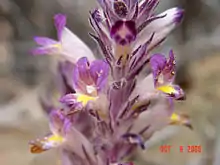Orobanche ludoviciana
Orobanche ludoviciana, the Louisiana broomrape[1] or prairie broom-rape, is a species of plant in the family Orobanchaceae. This parasitic plant is not specific, but especially favors Artemisia and Asteraceae. They grow from 1-3 dm often without branches. Leaves are scales and numerous. The inflorescences are many-flowered spikes that occupy a half to a third of the shoot. Flowers sessile or with small up to 15mm pedicels for the lower flowers. Calyx subtended by 1 or 2 bracts, which are bilabiate. Corolla is 1.5-2.5 cm and often a violet-like color. 2n=24, 48, 72, 96. Inhabits sandy soil. Found in Illinois and Indiana, as well as Saskatchewan to Texas, and west to California and northern Mexico. Found from June through August.[2] Listed as endangered in Wisconsin and threatened in Illinois and Indiana.
| Orobanche ludoviciana | |
|---|---|
 | |
| Scientific classification | |
| Kingdom: | Plantae |
| Clade: | Tracheophytes |
| Clade: | Angiosperms |
| Clade: | Eudicots |
| Clade: | Asterids |
| Order: | Lamiales |
| Family: | Orobanchaceae |
| Genus: | Orobanche |
| Species: | O. ludoviciana |
| Binomial name | |
| Orobanche ludoviciana | |
| Synonyms | |
|
List
| |
References
- "Orobanche ludoviciana". Natural Resources Conservation Service PLANTS Database. USDA. Retrieved 26 April 2016.
- Gleason & Cronquist (1991). Manual of Vascular Plants of Northeastern United States and Adjacent Canada. The New York Botanical Garden.